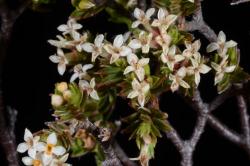- Taxon
- Gallery
A small, usually appressed shrub with mainly sympodial branching; short branches radiate from stout main stems. Young stems narrow, brown and sparsely hairy. Internodes 0.2–0.3 mm long. Old stems glabrous, grey to black. Node buttresses lunate to elongate, not very prominent on leafless stems. Leaves decussate, clustered at ends of young branchlets, ascending, imbricate, becoming patent, sessile or with very short, red petioles (0.1 mm). Lamina medium green, sometimes with red margins, broad–elliptic to ovate, 3–5 × 2–2.5 mm, adaxially concave to slightly keeled, mid-vein evident; tip obtuse or acute with blunt tip; base cuneate; abaxial surface covered with sparse hairs near distal end (becoming glabrous when older); stomata on both adaxial and abaxial leaf surfaces. Inflorescence terminal, 1–5-flowered. Involucral bracts 4, larger than adjacent leaves (5 × 3 mm). Receptacle sparsely hairy. Plants gynodioecious. Flowers white, on very short (0.1 mm) pedicels, sparsely covered with short hairs outside; inside hairless. ♀ tube 3 mm, ovary portion 2.4 mm, calyx lobes 1.5 × 0.8 mm; ♀ tube 4 mm long, ovary portion 2 mm, calyx lobes 2.1 × 1.4 mm. Anther dehiscence introrse. Ovary has abundant short hairs at summit. Fruits ovoid, fleshy, orange, 5 × 3.5 mm. Seeds ovoid, 3 × 1.8 mm. Flowering summer.
[Reproduced from Burrows (2011, New Zealand J. Bot. 49: 41–106) with permission from The Royal Society of New Zealand.]




